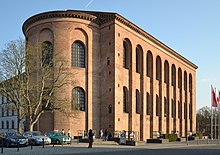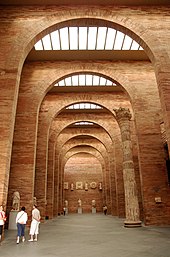
History of brick
History
Middle East and South Asia

The earliest bricks were dried mudbricks, meaning that they were formed from clay-bearing earth or mud and dried (usually in the sun) until they were strong enough for use. The oldest discovered bricks, originally made from shaped mud and dating before 7500 BC, were found at Tell Aswad, in the upper Tigris region and in southeast Anatolia close to Diyarbakir.
Mudbrick construction was used at Çatalhöyük, from c. 7,400 BC.
Mudbrick structures, dating to c. 7,200 BC have been located in Jericho, Jordan Valley.[6] These structures were made up of the first bricks with dimension 400x150x100 mm.
Between 5000 and 4500 BC, Mesopotamia had discovered fired brick. The standard brick sizes in Mesopotamia followed a general rule: the width of the dried or burned brick would be twice its thickness, and its length would be double its width.
The South Asian inhabitants of Mehrgarh also constructed air-dried mudbrick structures between 7000 and 3300 BC and later the ancient Indus Valley cities of Mohenjo-daro, Harappa, and Mehrgarh. Ceramic, or fired brick was used as early as 3000 BC in early Indus Valley cities like Kalibangan.
In the middle of the third millennium BC, there was a rise in monumental baked brick architecture in Indus cities. Examples included the Great Bath at Mohenjo-daro, the fire altars of Kaalibangan, and the granary of Harappa. There was a uniformity to the brick sizes throughout the Indus Valley region, conforming to the 1:2:4, thickness, width, and length ratio. As the Indus civilization began its decline at the start of the second millennium BC, Harappans migrated east, spreading their knowledge of brickmaking technology. This led to the rise of cities like Pataliputra, Kausambi, and Ujjain, where there was an enormous demand for kiln-made bricks.
By 604 BC, bricks were the construction materials for architectural wonders such as the Hanging Gardens of Babylon, where glazed fired bricks were put into practice.

China
The earliest fired bricks appeared in Neolithic China around 4400 BC at Chengtoushan, a walled settlement of the Daxi culture.[14] These bricks were made of red clay, fired on all sides to above 600 °C, and used as flooring for houses. By the Qujialing period (3300 BC), fired bricks were being used to pave roads and as building foundations at Chengtoushan.[15]
According to Lukas Nickel, the use of ceramic pieces for protecting and decorating floors and walls dates back at various cultural sites to 3000-2000 BC and perhaps even before, but these elements should be rather qualified as tiles. For the longest time builders relied on wood, mud and rammed earth, while fired brick and mudbrick played no structural role in architecture. Proper brick construction, for erecting walls and vaults, finally emerges in the third century BC, when baked bricks of regular shape began to be employed for vaulting underground tombs. Hollow brick tomb chambers rose in popularity as builders were forced to adapt due to a lack of readily available wood or stone.[16] The oldest extant brick building above ground is possibly Songyue Pagoda, dated to 523 AD.
By the end of the third century BC in China, both hollow and small bricks were available for use in building walls and ceilings. Fired bricks were first mass-produced during the construction of the tomb of China's first Emperor, Qin Shi Huangdi. The floors of the three pits of the terracotta army were paved with an estimated 230,000 bricks, with the majority measuring 28x14x7 cm, following a 4:2:1 ratio. The use of fired bricks in Chinese city walls first appeared in the Eastern Han dynasty (25 AD-220 AD).[17] Up until the Middle Ages, buildings in Central Asia were typically built with unbaked bricks. It was only starting in the ninth century CE when buildings were entirely constructed using fired bricks.[16]
The carpenter's manual Yingzao Fashi, published in 1103 at the time of the Song dynasty described the brick making process and glazing techniques then in use. Using the 17th-century encyclopaedic text Tiangong Kaiwu, historian Timothy Brook outlined the brick production process of Ming dynasty China:
...the kilnmaster had to make sure that the temperature inside the kiln stayed at a level that caused the clay to shimmer with the colour of molten gold or silver. He also had to know when to quench the kiln with water so as to produce the surface glaze. To anonymous labourers fell the less skilled stages of brick production: mixing clay and water, driving oxen over the mixture to trample it into a thick paste, scooping the paste into standardised wooden frames (to produce a brick roughly 42 cm long, 20 cm wide, and 10 cm thick), smoothing the surfaces with a wire-strung bow, removing them from the frames, printing the fronts and backs with stamps that indicated where the bricks came from and who made them, loading the kilns with fuel (likelier wood than coal), stacking the bricks in the kiln, removing them to cool while the kilns were still hot, and bundling them into pallets for transportation. It was hot, filthy work.
Europe


Early civilisations around the Mediterranean, including the Ancient Greeks and Romans, adopted the use of fired bricks. By the early first century CE, standardised fired bricks were being heavily produced in Rome.[18] The Roman legions operated mobile kilns,[19] and built large brick structures throughout the Roman Empire, stamping the bricks with the seal of the legion.[20] The Romans used brick for walls, arches, forts, aqueducts, etc. Notable mentions of Roman brick structures are the Herculaneum gate of Pompeii and the baths of Caracalla.[21]
During the Early Middle Ages the use of bricks in construction became popular in Northern Europe, after being introduced there from Northwestern Italy. An independent style of brick architecture, known as brick Gothic (similar to Gothic architecture) flourished in places that lacked indigenous sources of rocks. Examples of this architectural style can be found in modern-day Denmark, Germany, Poland, and Kaliningrad (former East Prussia).[22]

This style evolved into the Brick Renaissance as the stylistic changes associated with the Italian Renaissance spread to northern Europe, leading to the adoption of Renaissance elements into brick building. Identifiable attributes included a low-pitched hipped or flat roof, symmetrical facade, round arch entrances and windows, columns and pilasters, and more.[23]
A clear distinction between the two styles only developed at the transition to Baroque architecture. In Lübeck, for example, Brick Renaissance is clearly recognisable in buildings equipped with terracotta reliefs by the artist Statius von Düren, who was also active at Schwerin (Schwerin Castle) and Wismar (Fürstenhof).[24]
Long-distance bulk transport of bricks and other construction equipment remained prohibitively expensive until the development of modern transportation infrastructure, with the construction of canal, roads, and railways.[25]
Industrial era

Production of bricks increased massively with the onset of the Industrial Revolution and the rise in factory building in England. For reasons of speed and economy, bricks were increasingly preferred as building material to stone, even in areas where the stone was readily available. It was at this time in London that bright red brick was chosen for construction to make the buildings more visible in the heavy fog and to help prevent traffic accidents.
The transition from the traditional method of production known as hand-moulding to a mechanised form of mass-production slowly took place during the first half of the nineteenth century. The first brick-making machine was patented by Richard A. Ver Valen of Haverstraw, New York, in 1852. The Bradley & Craven Ltd 'Stiff-Plastic Brickmaking Machine' was patented in 1853. Bradley & Craven went on to be a dominant manufacturer of brickmaking machinery. Henry Clayton, employed at the Atlas Works in Middlesex, England, in 1855, patented a brick-making machine that was capable of producing up to 25,000 bricks daily with minimal supervision.[30] His mechanical apparatus soon achieved widespread attention after it was adopted for use by the South Eastern Railway Company for brick-making at their factory near Folkestone.
At the end of the 19th century, the Hudson River region of New York State would become the world's largest brick manufacturing region, with 130 brickyards lining the shores of the Hudson River from Mechanicsville to Haverstraw and employing 8,000 people. At its peak, about 1 billion bricks were produced a year, with many being sent to New York City for use in its construction industry.
The demand for high office building construction at the turn of the 20th century led to a much greater use of cast and wrought iron, and later, steel and concrete. The use of brick for skyscraper construction severely limited the size of the building – the Monadnock Building, built in 1896 in Chicago, required exceptionally thick walls to maintain the structural integrity of its 17 storeys.
Following pioneering work in the 1950s at the Swiss Federal Institute of Technology and the Building Research Establishment in Watford, UK, the use of improved masonry for the construction of tall structures up to 18 storeys high was made viable. However, the use of brick has largely remained restricted to small to medium-sized buildings, as steel and concrete remain superior materials for high-rise construction.












